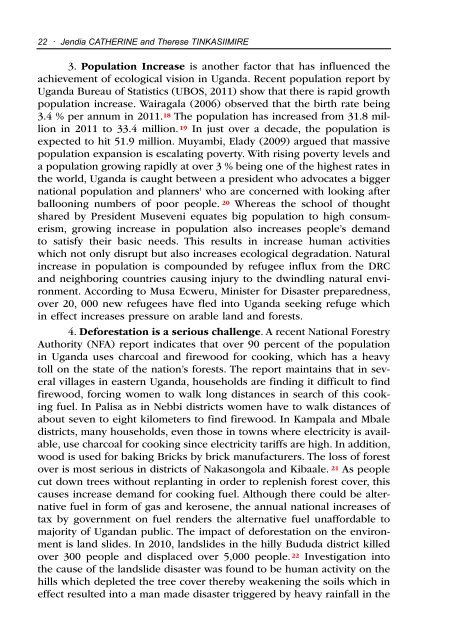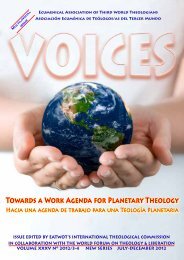voices-2013-2&3 - EATWOT's International Theological Commission
voices-2013-2&3 - EATWOT's International Theological Commission
voices-2013-2&3 - EATWOT's International Theological Commission
Create successful ePaper yourself
Turn your PDF publications into a flip-book with our unique Google optimized e-Paper software.
22 · Jendia CATHERINE and Therese TINKASIIMIRE3. Population Increase is another factor that has influenced theachievement of ecological vision in Uganda. Recent population report byUganda Bureau of Statistics (UBOS, 2011) show that there is rapid growthpopulation increase. Wairagala (2006) observed that the birth rate being3.4 % per annum in 2011. 18 The population has increased from 31.8 millionin 2011 to 33.4 million. 19 In just over a decade, the population isexpected to hit 51.9 million. Muyambi, Elady (2009) argued that massivepopulation expansion is escalating poverty. With rising poverty levels anda population growing rapidly at over 3 % being one of the highest rates inthe world, Uganda is caught between a president who advocates a biggernational population and planners' who are concerned with looking afterballooning numbers of poor people. 20 Whereas the school of thoughtshared by President Museveni equates big population to high consumerism,growing increase in population also increases people’s demandto satisfy their basic needs. This results in increase human activitieswhich not only disrupt but also increases ecological degradation. Naturalincrease in population is compounded by refugee influx from the DRCand neighboring countries causing injury to the dwindling natural environment.According to Musa Ecweru, Minister for Disaster preparedness,over 20, 000 new refugees have fled into Uganda seeking refuge whichin effect increases pressure on arable land and forests.4. Deforestation is a serious challenge. A recent National ForestryAuthority (NFA) report indicates that over 90 percent of the populationin Uganda uses charcoal and firewood for cooking, which has a heavytoll on the state of the nation’s forests. The report maintains that in severalvillages in eastern Uganda, households are finding it difficult to findfirewood, forcing women to walk long distances in search of this cookingfuel. In Palisa as in Nebbi districts women have to walk distances ofabout seven to eight kilometers to find firewood. In Kampala and Mbaledistricts, many households, even those in towns where electricity is available,use charcoal for cooking since electricity tariffs are high. In addition,wood is used for baking Bricks by brick manufacturers. The loss of forestover is most serious in districts of Nakasongola and Kibaale. 21 As peoplecut down trees without replanting in order to replenish forest cover, thiscauses increase demand for cooking fuel. Although there could be alternativefuel in form of gas and kerosene, the annual national increases oftax by government on fuel renders the alternative fuel unaffordable tomajority of Ugandan public. The impact of deforestation on the environmentis land slides. In 2010, landslides in the hilly Bududa district killedover 300 people and displaced over 5,000 people. 22 Investigation intothe cause of the landslide disaster was found to be human activity on thehills which depleted the tree cover thereby weakening the soils which ineffect resulted into a man made disaster triggered by heavy rainfall in the





